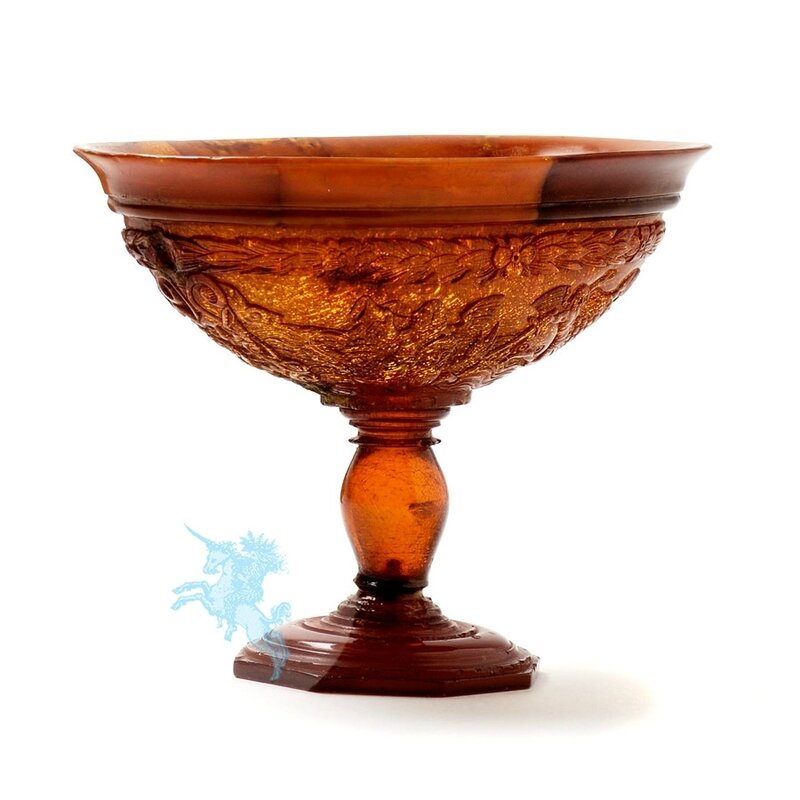Jacob Heise (verified 1654-1667 in Königsberg), Stem cup, Königsberg, ca 1660
Jacob Heise (verified 1654-1667 in Königsberg), Stem cup, Königsberg, ca 1660. Amber, Height 7.7 cm, width 10.5 cm. © Art Chamber Georg Laue
Published in: Laue, G .: Tresor. Treasures for European Kunstkammer, Munich 2017, pp. 156-157, pp. 234-235, Cat. No. 44; Werner, M./Laue, G .: Bernstein - Sigmar Polke - Amber, New York 2006, p. 76, p. 104; Laue, G .: Bernstein. Treasures of European Art Chambers. Amber. Treasuries for European Kunstkammer, Munich 2006, pp. 200-201, cat. no. 1; Seipel, W. (ed.): Amber for throne and altar. The gold of the sea in princely art and treasury chambers. Exhibition at the Alte Geistliche Schatzkammer, Kunsthistorisches Museum Vienna, Vienna 2005, pp. 60-61, cat. no. 30
Exhibited at: Michael Werner Gallery New York, "Bernstein - Sigmar Polke - Amber", November 7, 2006-January 13, 2007; Kunsthistorisches Museum Wien, Alte Geistliche Schatzkammer, "Amber for throne and altar. The Gold of the Sea in Princely Art and Treasuries ", October 5, 2005- January 29, 2006
Worked from a single piece of transparent amber, the oval bowl of the dish rises above a clear, balaster stem. The everted lip is made of several joined pieces of cloudy amber. An oval medallion of transparent amber is set into the floor of the bowl. It covers a carved ivory relief showing a recumbent nude female figure with a raised wine cup - to Allegory of Abundance. Marine scenes are carved in high relief in the clear amber wall of the bowl. Winged putti on scaly sea monsters populate a turbulent marine landscape. A border of floral and foliate decoration runs all the way around the scenes, which are punctured at intervals by horned mascarons.
Both the exceptionally high quality of the workmanship distinguishes this small dish and the marine representations point unequivocally to the Königsberg master in amber Jacob Heise. The attribution to him is based on the fact that he is in the possession of the king. Originally conceived as a diplomatic gift of the first order, it was sent in 1662 as a state present by Friedrich Wilhelm, Elector of Brandenburg, to Johann Georg II, Elector of Saxony (inv. No. IV 340). A nautilus vessel in Königsberg Palace has been listed as lost since 1945. The magnificent vessel made by Heise in 1654 in turn shows virtually identical marine scenes with winged putti on sea monsters (Rohde 1937, nos 130 and 131, pl 55). (1937, nos. 137 and 138), which is the first of the most famous and most famous of the world.
The small dish represents a significant addition to the known work of the important master in amber Jacob Heise.

/https%3A%2F%2Fprofilepics.canalblog.com%2Fprofilepics%2F1%2F0%2F100183.jpg)
/https%3A%2F%2Fstorage.canalblog.com%2F03%2F02%2F119589%2F96711876_o.jpg)
/https%3A%2F%2Fstorage.canalblog.com%2F11%2F31%2F119589%2F94773502_o.jpg)
/https%3A%2F%2Fstorage.canalblog.com%2F20%2F83%2F119589%2F94772815_o.jpg)
/https%3A%2F%2Fstorage.canalblog.com%2F26%2F72%2F119589%2F75604929_o.jpg)
/https%3A%2F%2Fstorage.canalblog.com%2F59%2F60%2F119589%2F26458628_o.jpg)



/http%3A%2F%2Fstorage.canalblog.com%2F67%2F75%2F119589%2F129500711_o.jpg)
/http%3A%2F%2Fstorage.canalblog.com%2F89%2F26%2F119589%2F129483573_o.jpg)
/http%3A%2F%2Fstorage.canalblog.com%2F29%2F50%2F119589%2F128346203_o.jpg)
/http%3A%2F%2Fstorage.canalblog.com%2F12%2F58%2F119589%2F126075412_o.jpg)